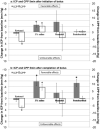Effectiveness of Pharmacological Therapies for Intracranial Hypertension in Children With Severe Traumatic Brain Injury--Results From an Automated Data Collection System Time-Synched to Drug Administration
- PMID: 26673840
- PMCID: PMC4779724
- DOI: 10.1097/PCC.0000000000000610
Effectiveness of Pharmacological Therapies for Intracranial Hypertension in Children With Severe Traumatic Brain Injury--Results From an Automated Data Collection System Time-Synched to Drug Administration
Abstract
Objectives: To describe acute cerebral hemodynamic effects of medications commonly used to treat intracranial hypertension in children with traumatic brain injury. Currently, data supporting the efficacy of these medications are insufficient.
Design: In this prospective observational study, intracranial hypertension (intracranial pressure ≥ 20 mm Hg for > 5 min) was treated by clinical protocol. Administration times of medications for intracranial hypertension (fentanyl, 3% hypertonic saline, mannitol, and pentobarbital) were prospectively recorded and synchronized with an automated database that collected intracranial pressure and cerebral perfusion pressure every 5 seconds. Intracranial pressure crises confounded by external stimulation or mechanical ventilator adjustments were excluded. Mean intracranial pressure and cerebral perfusion pressure from epochs following drug administration were compared with baseline values using Kruskal-Wallis analysis of variance and Dunn test. Frailty modeling was used to analyze the time to intracranial pressure crisis resolution. Mixed-effect models compared intracranial pressure and cerebral perfusion pressure 5 minutes after the medication versus baseline and rates of treatment failure.
Setting: A tertiary care children's hospital.
Patients: Children with severe traumatic brain injury (Glasgow Coma Scale score ≤ 8).
Interventions: None.
Measurements and main results: We analyzed 196 doses of fentanyl, hypertonic saline, mannitol, and pentobarbital administered to 16 children (median: 12 doses per patient). Overall, intracranial pressure significantly decreased following the administration of fentanyl, hypertonic saline, and pentobarbital. After controlling for administration of multiple medications, intracranial pressure was decreased following hypertonic saline and pentobarbital administration; cerebral perfusion pressure was decreased following fentanyl and was increased following hypertonic saline administration. After adjusting for significant covariates (including age, Glasgow Coma Scale score, and intracranial pressure), hypertonic saline was associated with a two-fold faster resolution of intracranial hypertension than either fentanyl or pentobarbital. Fentanyl was significantly associated with the most frequent treatment failure.
Conclusions: Intracranial pressure decreased after multiple drug administrations, but hypertonic saline may warrant consideration as the first-line drug for treating intracranial hypertension, as it was associated with the most favorable cerebral hemodynamics and fastest resolution of intracranial hypertension.
Figures




Comment in
-
About Intracranial Hypertension in Pediatric Patients: Good News About Treatment...But What About the Role of Optic Nerve Sheath Diameter Measurement in the Diagnosis?Pediatr Crit Care Med. 2016 Jul;17(7):706-7. doi: 10.1097/PCC.0000000000000812. Pediatr Crit Care Med. 2016. PMID: 27387784 No abstract available.
-
The authors reply.Pediatr Crit Care Med. 2016 Jul;17(7):707-8. doi: 10.1097/PCC.0000000000000811. Pediatr Crit Care Med. 2016. PMID: 27387785 Free PMC article. No abstract available.
References
-
- Hyder AA, Wunderlich CA, Puvanachandra P, et al. The impact of traumatic brain injuries: a global perspective. NeuroRehabilitation. 2007;22(5):341–353. - PubMed
-
- Adelson PD, Ragheb J, Kanev P, et al. Phase II clinical trial of moderate hypothermia after severe traumatic brain injury in children. Neurosurgery. 2005;56(4):740–754. discussion 740-754. - PubMed
-
- Barzilay Z, Augarten A, Sagy M, et al. Variables affecting outcome from severe brain injury in children. Intensive Care Med. 1988;14(4):417–421. - PubMed
-
- Downard C, Hulka F, Mullins RJ, et al. Relationship of cerebral perfusion pressure and survival in pediatric brain-injured patients. J Trauma. 2000;49(4):654–658. discussion 658-659. - PubMed
-
- Esparza J, J MP, Sarabia M, et al. Outcome in children with severe head injuries. Childs Nerv Syst. 1985;1(2):109–114. - PubMed
Publication types
MeSH terms
Substances
Grants and funding
LinkOut - more resources
Full Text Sources
Other Literature Sources
Medical

